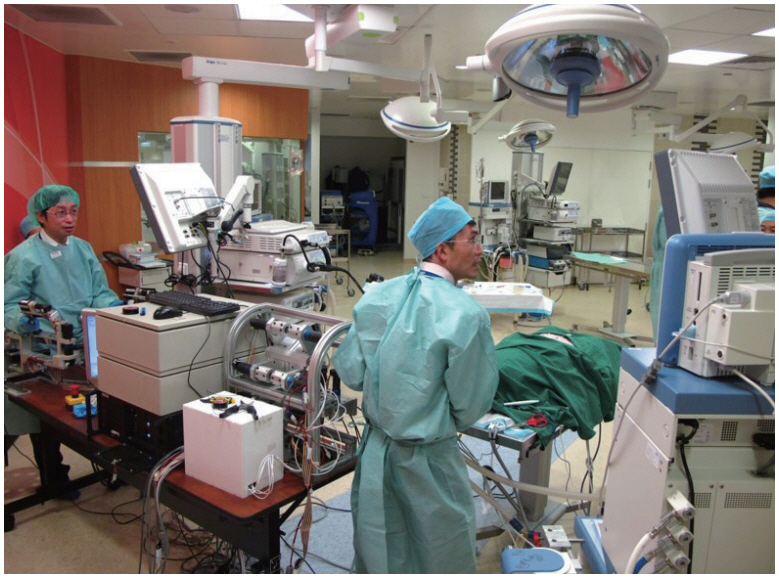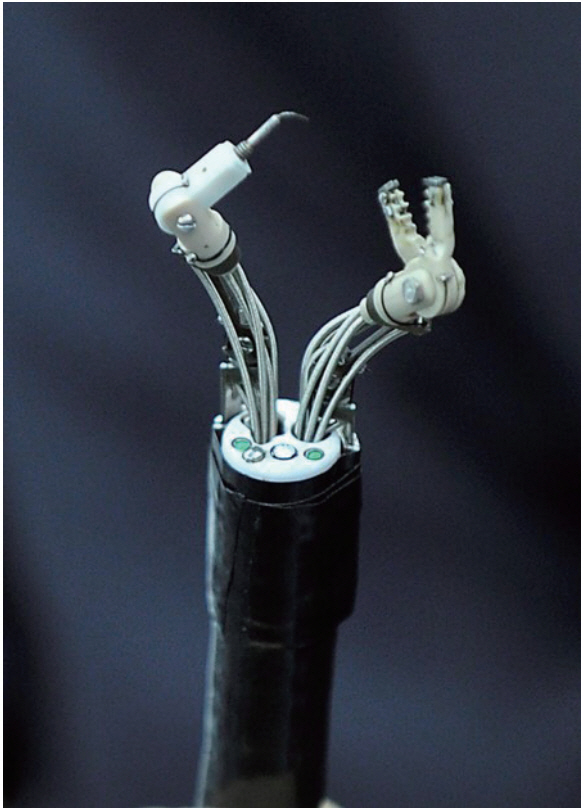Clin Endosc.
2018 Nov;51(6):552-557. 10.5946/ce.2018.089.
Robotics for Advanced Therapeutic Colonoscopy
- Affiliations
-
- 1Department of Medicine, Yong Loo Lin School of Medicine, National University of Singapore, Singapore. mdchoky@nus.edu.sg
- KMID: 2430397
- DOI: http://doi.org/10.5946/ce.2018.089
Abstract
- Although colonoscopy was originally a diagnostic imaging procedure, it has now expanded to include an increasing range of therapeutic interventions. These procedures require precise maneuvers of instruments, execution of force, efficient transmission of force from the operator to the point of application, and sufficient dexterity in the mobilization of endoscopic surgical instruments. The conventional endoscope is not designed to support technically demanding endoscopic procedures. In case of colonoscopy, the tortuous anatomy of the colon makes inserting, moving, and orientating the endoscope difficult. Exerting excessive pressure can cause looping of the endoscope, pain to the patient, and even perforation of the colon. To mitigate the technical constraints, numerous technically enhanced systems have been developed to enable better control of instruments and precise delivery of force in the execution of surgical tasks such as apposing, grasping, traction, counter-traction, and cutting of tissues. Among the recent developments are highly dexterous robotic master and slave systems, computer-assisted or robotically enhanced conventional endoscopes, and autonomously driven locomotion devices that can effortlessly traverse the colon. Developments in endoscopic instrumentations have overcome technical barriers and opened new horizons for further advancements in therapeutic interventions. This review describes examples of some of these systems in the context of their applications to advanced therapeutic colonoscopy.
MeSH Terms
Figure
Cited by 1 articles
-
Editors' Choice of Noteworthy Clinical Endoscopy Publications in the First Decade
Gwang Ha Kim, Kwang An Kwon, Do Hyun Park, Jimin Han
Clin Endosc. 2021;54(5):633-640. doi: 10.5946/ce.2021.216.
Reference
-
1. ASGE Training Committee, Sedlack RE, Coyle WJ, et al. ASGE’s assessment of competency in endoscopy evaluation tools for colonoscopy and EGD. Gastrointest Endosc. 2014; 79:1–7.
Article2. Fujishiro M, Yahagi N, Kakushima N, et al. Outcomes of endoscopic submucosal dissection for colorectal epithelial neoplasms in 200 consecutive cases. Clin Gastroenterol Hepatol. 2007; 5:678–683. quiz 645.
Article3. Saito Y, Fukuzawa M, Matsuda T, et al. Clinical outcome of endoscopic submucosal dissection versus endoscopic mucosal resection of large colorectal tumors as determined by curative resection. Surg Endosc. 2010; 24:343–352.
Article4. Tanaka S, Oka S, Kaneko I, et al. Endoscopic submucosal dissection for colorectal neoplasia: possibility of standardization. Gastrointest Endosc. 2007; 66:100–107.
Article5. Yoon JY, Kim JH, Lee JY, et al. Clinical outcomes for patients with perforations during endoscopic submucosal dissection of laterally spreading tumors of the colorectum. Surg Endosc. 2013; 27:487–493.
Article6. Phee SJ, Low SC, Huynh VA, Kencana AP, Sun ZL, Yang K. Master and slave transluminal endoscopic robot (MASTER) for natural orifice transluminal endoscopic surgery (NOTES). Conf Proc IEEE Eng Med Biol Soc. 2009; 2009:1192–1195.
Article7. Wang Z, Phee SJ, Lomanto D, et al. Endoscopic submucosal dissection of gastric lesions by using a master and slave transluminal endoscopic robot: an animal survival study. Endoscopy. 2012; 44:690–694.
Article8. Ho KY, Phee SJ, Shabbir A, et al. Endoscopic submucosal dissection of gastric lesions by using a master and slave transluminal endoscopic robot (MASTER). Gastrointest Endosc. 2010; 72:593–599.
Article9. Phee SJ, Reddy N, Chiu PW, et al. Robot-assisted endoscopic submucosal dissection is effective in treating patients with early-stage gastric neoplasia. Clin Gastroenterol Hepatol. 2012; 10:1117–1121.
Article10. Phee SJ, Ho KY, Lomanto D, et al. Natural orifice transgastric endoscopic wedge hepatic resection in an experimental model using an intuitively controlled master and slave transluminal endoscopic robot (MASTER). Surg Endosc. 2010; 24:2293–2298.
Article11. Chiu PW, Phee SJ, Wang Z, et al. Feasibility of full-thickness gastric resection using master and slave transluminal endoscopic robot and closure by Overstitch: a preclinical study. Surg Endosc. 2014; 28:319–324.
Article12. Diana M, Chung H, Liu KH, et al. Endoluminal surgical triangulation: overcoming challenges of colonic endoscopic submucosal dissections using a novel flexible endoscopic surgical platform: feasibility study in a porcine model. Surg Endosc. 2013; 27:4130–4135.
Article13. Suzuki N, Hattori A, Tanoue K, et al. Scorpion shaped endoscopic surgical robot for NOTES and SPS with augmented reality functions. In : Medical Imaging and Augmented Reality - 5th International Workshop, MIAR 2010; 2010 Sep 19-20; Beijing. Berlin: Springer-Verlag Berlin Heidelberg;2010. 541–550.
Article14. Rothstein RI, Ailinger RA, Peine W. Computer-assisted endoscopic robot system for advanced therapeutic procedures. Gastrointest Endosc. 2004; 59:P113.
Article15. Franzino RJ. The Laprotek surgical system and the next generation of robotics. Surg Clin North Am. 2003; 83:1317–1320.
Article16. Woo J, Choi JH, Seo JT, Kim TI, Yi BJ. Development of a robotic colonoscopic manipulation system, using haptic feedback algorithm. Yonsei Med J. 2017; 58:139–143.
Article17. Kwok KW, Tsoi KH, Vitiello V, et al. Dimensionality reduction in controlling articulated snake robot for endoscopy under dynamic active constraints. IEEE Trans Robot. 2013; 29:15–31.
Article18. Patel N, Seneci CA, Shang J, et al. Evaluation of a novel flexible snake robot for endoluminal surgery. Surg Endosc. 2015; 29:3349–3355.
Article19. Warren A, Mountney P, Noonan D, Yang GZ. Horizon stabilized--dynamic view expansion for robotic assisted surgery (HS-DVE). Int J Comput Assist Radiol Surg. 2012; 7:281–288.
Article20. Atallah S. Assessment of a flexible robotic system for endoluminal applications and transanal total mesorectal excision (taTME): could this be the solution we have been searching for? Tech Coloproctol. 2017; 21:809–814.
Article21. Eickhoff A, van Dam J, Jakobs R, et al. Computer-assisted colonoscopy (the NeoGuide Endoscopy System): results of the first human clinical trial (“PACE study”). Am J Gastroenterol. 2007; 102:261–266.
Article22. Bianchi F, Ciuti G, Koulaouzidis A, et al. An innovative robotic platform for magnetically-driven painless colonoscopy. Ann Transl Med. 2017; 5:421.
Article23. Tumino E, Sacco R, Bertini M, Bertoni M, Parisi G, Capria A. Endotics system vs colonoscopy for the detection of polyps. World J Gastroenterol. 2010; 16:5452–5456.24. Gluck N, Fishman S, Melhem A, Goldfarb S, Halpern Z, Santo E. A novel colonoscope with panoramic visualization detected more simulated polyps than conventional colonoscopy in a live swine model. Endosc Int Open. 2015; 3:E642–E645.
Article25. Gluck N, Melhem A, Halpern Z, Mergener K, Santo E. A novel self-propelled disposable colonoscope is effective for colonoscopy in humans (with video). Gastrointest Endosc. 2016; 83:998–1004.e1.
Article26. Iwasa T, Nakadate R, Onogi S, et al. A new robotic-assisted flexible endoscope with single-hand control: endoscopic submucosal dissection in the ex vivo porcine stomach. Surg Endosc. 2018; 32:3386–3392.
Article27. Rösch T, Adler A, Pohl H, et al. A motor-driven single-use colonoscope controlled with a hand-held device: a feasibility study in volunteers. Gastrointest Endosc. 2008; 67:1139–1146.
Article28. Huberty V, Ibrahim M, Hiernaux M, Chau A, Dugardeyn S, Deviere J. Safety and feasibility of an endoluminal-suturing device for endoscopic gastric reduction (with video). Gastrointest Endosc. 2017; 85:833–837.
Article29. van der Stap N, Rozeboom ED, Pullens HJ, van der Heijden F, Broeders IA. Feasibility of automated target centralization in colonoscopy. Int J Comput Assist Radiol Surg. 2016; 11:457–465.
Article30. Pullens HJ, van der Stap N, Rozeboom ED, et al. Colonoscopy with robotic steering and automated lumen centralization: a feasibility study in a colon model. Endoscopy. 2016; 48:286–290.
Article
- Full Text Links
- Actions
-
Cited
- CITED
-
- Close
- Share
- Similar articles
-
- The development of robotic flexible endoscopic platforms
- Development of a Robotic Colonoscopic Manipulation System, Using Haptic Feedback Algorithm
- Brain-machine Interface in Robot-assisted Neurorehabilitation for Patients with Stroke and Upper Extremity Weakness – the Therapeutic Turning Point
- Use of robots in rehabilitative treatment
- Robotics and Gastrointestinal Surgery



